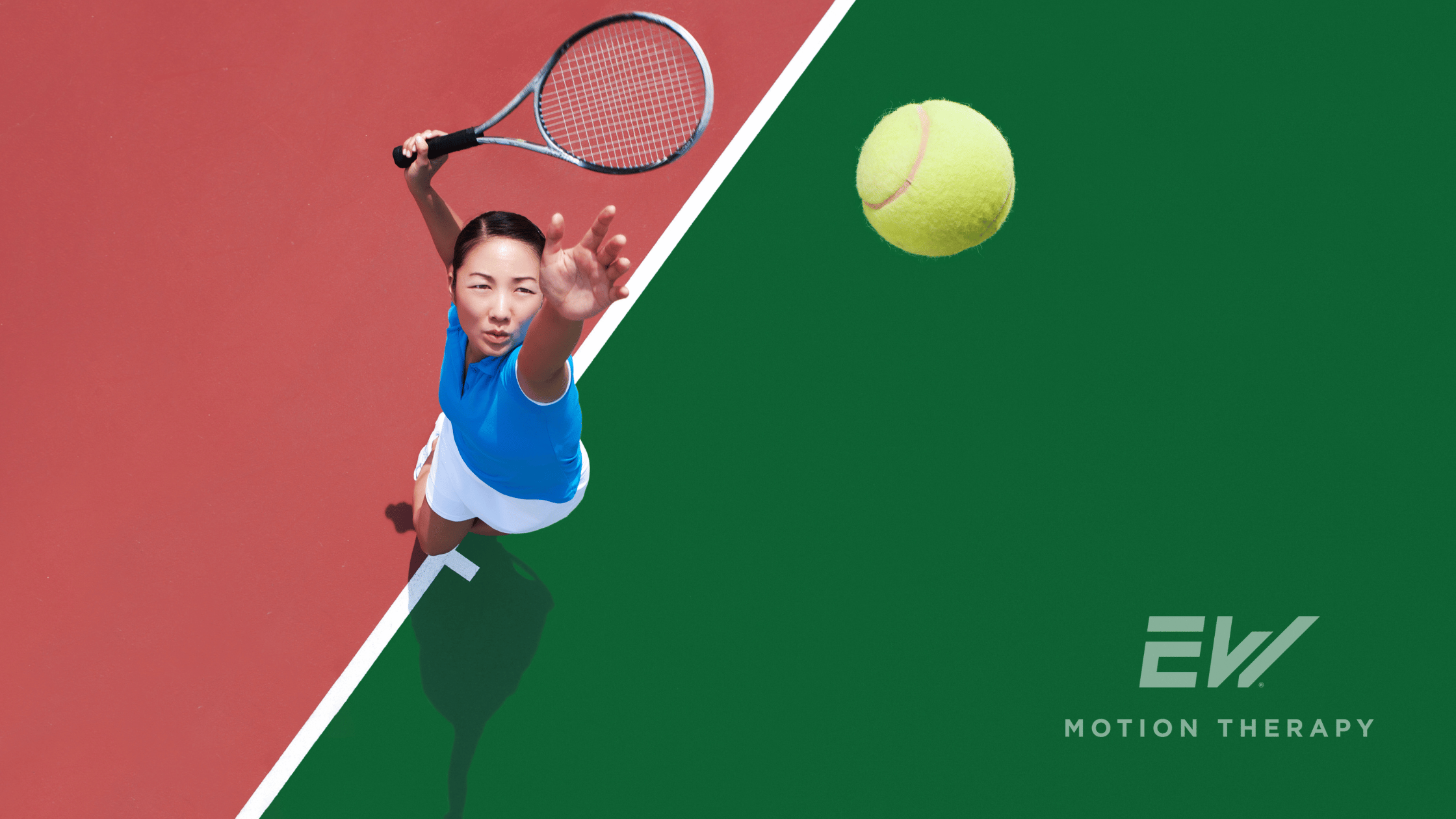How to Improve Your Tennis Serve: Body Mechanics and How Physical Therapy Can Help

Licensed Physical Therapist, PT, DPT // EW Motion Therapy Trussville
The tennis serve is one of the most complex and powerful movements in sports, involving coordination, timing, strength, and technique. Improving your serve requires attention to these factors, as well as a strong foundation of mobility and stability in the upper and lower body. In this article, we’ll break down the movements involved in a serve, explore common reasons your serve might not be effective, and discuss how physical therapy can help fine-tune your body for optimal performance.
Understanding the body movements involved in a tennis serve
A powerful and accurate tennis serve involves a series of coordinated movements, starting with your feet and moving up through your legs, core, shoulders, and arms. The following components are essential to a serve:
Stance and setup
The serve begins with a solid stance. Players often position their feet in either a platform stance (feet roughly shoulder-width apart) or a pinpoint stance (bringing the back foot up closer to the front foot). A stable foundation helps create a consistent rhythm and enables a controlled transfer of power.
Wind-up and backswing
As you start the backswing, your non-dominant hand (typically the left for right-handed players) tosses the ball while your dominant arm draws back in preparation for the hit. During this wind-up, your core engages to stabilize your torso, and the shoulder externally rotates to allow for a larger range of motion. This phase sets up the kinetic chain needed to deliver power to the ball.
Leg drive and core engagement
The lower body plays a crucial role in the serve. As you approach the peak of your backswing, the legs bend to generate force, which then drives upward. This leg drive transfers power from the ground up through the body. Simultaneously, the core remains activated, facilitating control over the trunk and adding torque to the motion.
Shoulder rotation and arm acceleration
As the dominant shoulder accelerates forward, the non-dominant shoulder and arm assist by providing counterbalance. This shoulder rotation, combined with arm acceleration, is essential for achieving speed. The elbow must be high, and the wrist must remain loose to whip the racket with maximum speed.
Contact and follow-through
At the peak of the motion, contact with the ball occurs. Timing is critical here, as even a slight deviation in timing or hand position can cause errors in accuracy or power. After contact, the arm follows through across the body. This follow-through helps reduce strain on the shoulder and ensures energy disperses safely.
Reasons your serve might not be effective
Despite hours of practice, your serve might still lack power, accuracy, or consistency. Here are some common reasons why:
Insufficient body rotation or hip drive
If you’re not rotating your hips and shoulders enough, you lose a significant portion of your power potential. This lack of rotation can cause your serve to feel stiff and underpowered. Additionally, weak hip and core muscles can impair your ability to maintain balance, making it difficult to generate explosive power from the ground up.
Inadequate shoulder and core stability
Serving places substantial demands on the shoulder joint and core. Weakness or instability in these areas can cause inaccurate ball placement and potentially lead to injuries, especially in the rotator cuff muscles and scapular stabilizers. The shoulder is a highly mobile joint, and without adequate stability, it is vulnerable to stress during the serve.
Poor timing of the toss
The toss is the foundation of a good serve. If the toss is inconsistent, too high, or too low, it affects the entire sequence of movements. An off-target toss can disrupt timing, causing the arm and wrist to compensate, which affects both accuracy and power.
Limited mobility or range of motion
Limited shoulder or wrist mobility can restrict your range of motion, leading to a compromised serve. Reduced flexibility in the chest, shoulder, and upper back can also impede your ability to rotate fully. If your shoulder cannot move through its full range, you may struggle to achieve the optimal racket speed and angle.
Fatigue and lack of endurance
A strong serve demands stamina. If your muscles fatigue easily, maintaining proper form throughout a match becomes challenging. This is particularly true in longer games, where even a slight drop in power or accuracy could cost critical points.
How physical therapy can help improve your tennis serve
Physical therapy plays a key role in enhancing the musculoskeletal elements necessary for a powerful, accurate tennis serve. Physical therapists can assess your movement patterns, identify imbalances, and develop a program to strengthen and stabilize your body for a more effective serve.
Strengthening the core and lower body
A physical therapist can guide you through exercises targeting the core, hips, and lower body to improve stability, balance, and power transfer. Squats, lunges, and rotational exercises can enhance the hip drive and core engagement needed for a strong serve. Core stability exercises, such as planks and anti-rotation movements, reinforce the muscles around the torso and pelvis, creating a solid base for your serve.
Improving shoulder and rotator cuff stability
The shoulder complex is vulnerable to strain, especially during high-velocity movements like the serve. Physical therapists focus on strengthening the rotator cuff and scapular stabilizers to reduce the risk of injury. Exercises such as external rotations, internal rotations, and serratus anterior activation drills help reinforce the shoulder’s support structures. Improving scapular control through targeted exercises can provide the stability needed for effective shoulder rotation and arm acceleration.
Increasing mobility and flexibility
Tightness in the shoulders, chest, or back can limit your ability to achieve a full range of motion during a serve. A physical therapist can use stretching, myofascial release, and joint mobilization techniques to enhance flexibility. Dynamic stretches, particularly for the chest and shoulders, and thoracic spine mobility exercises can help improve rotation and allow for a smoother follow-through motion.
Correcting movement patterns and addressing imbalances
A physical therapist can identify any movement inefficiencies, such as compensations in the hips, knees, or back. By addressing these issues, therapy helps prevent energy leaks in the kinetic chain, allowing you to maximize the transfer of power from your lower body to your upper body. Correcting these movement patterns not only enhances your serve but also helps prevent injuries caused by repetitive strain.
Developing endurance and neuromuscular coordination
Physical therapy programs often incorporate endurance training to build the muscle stamina required for repetitive serves. Additionally, neuromuscular coordination drills enhance timing and rhythm, which are crucial for a consistent toss and smooth follow-through. Reaction and coordination exercises can improve your ability to anticipate movements and react with better control, helping maintain precision even in high-pressure scenarios.
Individualized approach based on biomechanics
Everyone has unique biomechanics, which means that your serving technique might require specific adjustments. A physical therapist can tailor a program to address your particular strengths and limitations, focusing on the areas most critical to your serving performance. This personalized approach ensures that your efforts in training yield the maximum benefit for your game.
Practical tips to start enhancing your serve today
While working with a physical therapist is ideal, here are a few exercises and tips you can integrate into your routine to start seeing improvements:
- Focus on core strength: Add core exercises like Russian twists, medicine ball throws, and cable rotations to your workout. Core stability is essential for effective power transfer during a serve.
- Improve shoulder mobility: Incorporate shoulder mobility drills like wall slides, shoulder dislocations with a resistance band, and thoracic spine rotations. Enhanced mobility will help you achieve a smooth, full swing.
- Practice toss accuracy: Spend a few minutes each day working on a consistent toss. Try tossing to a specific target and maintain the same height and trajectory. This will improve the rhythm and timing of your serve.
- Build leg strength and endurance: Exercises such as jump squats, lunges, and calf raises can help build lower body strength and stamina, providing a more stable foundation for your serve.
A powerful, effective serve requires more than just practice; it demands a well-prepared, strong, and stable body. Understanding the mechanics of a serve and recognizing areas for improvement are crucial steps in refining your technique. Physical therapy can be a valuable tool in your training, helping address muscular imbalances, increase mobility, and build strength in critical areas. By working with a physical therapist and incorporating targeted exercises, you can enhance your serve’s accuracy, power, and consistency, elevating your performance on the court and reducing your risk of injury. We love helping our tennis players at EW Motion Therapy address biomechanical imbalances so they can play their best game. To learn more about what physical therapy might cost you, click the button below to download our free pricing guide.


